How QRPEM Calculates Covariate Parameters
Linear regression is used to find the covariate parameters such as dCldWt, etc.
In this equation:

 is the lth element in the averaged structural parameter array for subject i.
is the lth element in the averaged structural parameter array for subject i.
C(i)lj is the (l, j) element in the C matrix for subject i.
 is the noise term.
is the noise term.
Looking at the matrix form in the “C Matrix example” section,
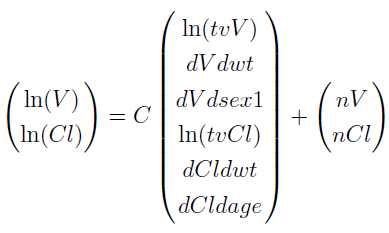
 is the lth element in the vector
is the lth element in the vector  for subject i.
for subject i.
where
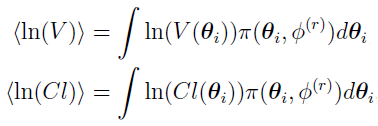
Both  and
and  are obtained by averaging the samples of ln(V(
are obtained by averaging the samples of ln(V( )) and ln(Cl(
)) and ln(Cl( )) during the Monte Carlo process.
)) during the Monte Carlo process.
The C(i)lj in the first equation of this section

is the element in the lth row and jth column of the C matrix for subject i. In this example, the C matrix is the 2 by 6 matrix as shown below

Each subject has a different C matrix. The size of the C matrix is leneta (number of unfrozen etas) by nbasetheta (number of unfrozen population (typical) parameters plus the covariate parameters.
The  j in the first equation of this section is the jth element of the vector to be obtained by linear regression.
j in the first equation of this section is the jth element of the vector to be obtained by linear regression.
In this example, the vector  is
is
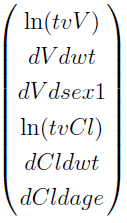
and  is the same across all the subjects.
is the same across all the subjects.
To find  , first sum over all the subjects, i.e.,
, first sum over all the subjects, i.e.,  .
.
Defining  and
and  , and taking
, and taking  as the lth element in the
as the lth element in the  vector,
vector,
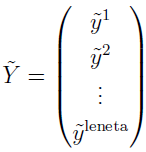
and taking  as the (l, j) element of the
as the (l, j) element of the  matrix, i.e.,
matrix, i.e.,
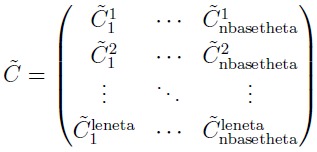
Then the earlier summation:

can be written as the matrix form  , where
, where  is a noise vector. The purpose of the linear regression is to find the
is a noise vector. The purpose of the linear regression is to find the  vector such that the noise ϵ is minimized. The least-squares estimation of
vector such that the noise ϵ is minimized. The least-squares estimation of  is by simply solving the
is by simply solving the  for
for  .
.
 can be found by calling the LAPACK subroutine DPOTRF followed by DPOTRS. In fact, in QRPEM, it is trying to find a
can be found by calling the LAPACK subroutine DPOTRF followed by DPOTRS. In fact, in QRPEM, it is trying to find a  from the equation
from the equation  , where
, where  0 is the
0 is the  from the last iteration, and
from the last iteration, and  is just the covariance matrix of the population parameters.
is just the covariance matrix of the population parameters.
Defining  and
and  , the previous equation becomes
, the previous equation becomes  .
.
Again,  is found by calling the LAPACK subroutine DPOTRF followed by DPOTRS. The new
is found by calling the LAPACK subroutine DPOTRF followed by DPOTRS. The new  for the next iteration is
for the next iteration is  .
.